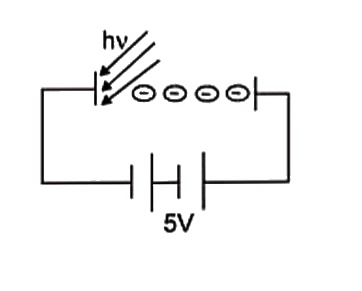When cathode C of photocell is incident with photon of 5 eV energy ,maximum KE of electron emitted is 2 eV.For which value of stopping potential on anode (A) photo incident with energy of 6 eV,number of electron reaching to anode will become zero?Solution in Gujrati
−1V
−3V
+3V
+4V
The correct Answer is:B
12m2max=hf−ϕ0
2=5-ϕ0
∴ϕ0=3eV
Again eV0=hf−ϕ0 3 eV
∴V0=3eV
∴VC−VA=3V
∴0−VA=3V
∴VA=−3V
Topper's Solved these Questions
- DUAL NATURE OF RADIATION AND MATTERBOOK - KUMAR PRAKASHANCHAPTER - DUAL NATURE OF RADIATION AND MATTEREXERCISE - Section-D (MCQs asked in CBSE-PMT,AIPMT,NEET)
1 Videos
- DUAL NATURE OF RADIATION AND MATTERBOOK - KUMAR PRAKASHANCHAPTER - DUAL NATURE OF RADIATION AND MATTEREXERCISE - Section-D (MCQs asked in AIIMS)
55 Videos
- DUAL NATURE OF RADIATION AND MATTERBOOK - KUMAR PRAKASHANCHAPTER - DUAL NATURE OF RADIATION AND MATTEREXERCISE - Section-D (MCQ based on Textual Illustrations and Exercise)
1 Videos
- CURRENT ELECTRICITYBOOK - KUMAR PRAKASHANCHAPTER - CURRENT ELECTRICITYEXERCISE - SECTION [D] MULTIPLE CHOICE QUESTIONS (MCQs) (MCQs ASKED IN BOARD EXAM AND GUJCET)
23 Videos
- ELECTRIC CHARGES AND FIELDS BOOK - KUMAR PRAKASHANCHAPTER - ELECTRIC CHARGES AND FIELDS EXERCISE - SECTION D MCQS ASKED IN COMPETITIVE EXAMES (MCQS AKSED IN BOARD EXAM AND GUJCET)
14 Videos
Similar Questions
Work function of metal in photoelectric effect is 3.5 eV for -1.2 V potential photoelectric current become zero,Hence…….
View SolutionWhich phenomena shows both particle and wave nature of electromagnetic waves and electron?
View SolutionAn electric bulb of 100 W converts 3% of electrical energy into light energy.If the wavelength of light emitted is 6625 Å,the number of photons emitted in 1 s is………..
(h=6.625×10−34)JS
View SolutionA wire is bent in the form of circle of radius 2m. Resistance per unit length of wire is 1πΩm. Battery of 6 V is connected between A and B ∠AOB=90∘ . Find the current through the battery.

View SolutionWhen air is replaced by dielectric medium of constant K, the maximum force of attraction between two charges separated by distance d, ..........
View SolutionPhotons with energy 5eV are incident on a cathode C in a photoelectric cell . The maximum energy of emitted photoelectrons is 2eV. When photons of energy 6eV are incident on C , no photoelectrons will reach the anode A , if the stopping potential of A relative to C is
View Solutionकिसी प्रकाशवैधुत सेल के कैथोड C पर 5 eV ऊर्जा के फोटॉन आपतित होते हैं । उत्सर्जित प्रकाश इलेक्ट्रॉनों की अधिकतम गतिज ऊर्जा 2 eV है । 6 eV ऊर्जा के फोटॉनों के C पर आपतित होने पर कोई भी प्रकाश इलेक्ट्रॉन एनोड A तक नहीं पहुँचेगा, यदि C के सापेक्ष A का निरोधी विभव है :
View SolutionA monochromatic ray of photons of energy 5 eV are incident on cathode. Electrons reaching the anode have kinetic energyies varying from 6 eV to 8eV.Choose the correct option.

View SolutionWork function of a cathode is 4.2 eV. Energy of incident photons is 6.2eV. Anode is kept at +2 volt w.r.t cathode. Calculate minimum and maximum K.E. of electrons reaching at the anode.
View SolutionPhotons of energy 5 eV and incident on a cathode made of a photosensitive plate. The maximum kinetic energy of emitted photoelectrons is 3 eV . When photons of energy 8 eV fall on the same metal plate , the stopping potential of anode plate will be
View Solutionएक धातु के पृष्ठ पर 6eV ऊर्जा के फोटॉन आपतित होते हैं तब उत्सर्जित फोटो-इलेक्ट्रॉन की अधिकतम गतिज ऊर्जा 5 eV होती है। निरोधी विभव होना चाहिए
View Solution5 eV ऊर्जा वाले फोटोन एक फोटोन सेल के कैथोड़ C पर आपतित होता है, उत्सर्जित फोटो इलेक्ट्रान की अधिकतम गतिज उर्जा 2ev है। यदि 6evऊर्जा का फोटोन कैथोड़C पर आता है तो कोई इलेक्ट्रॉन एनोड A पर नही पहुँच जाएगा यदि के सापेक्ष A का निरोधी विभव हो-
View SolutionPhotons of energy 6eV are incident on a metal surface whose work function is 4eV. The minimum kinetic energy of the emitted photo - electrons will be
View SolutionPhotons with energy 5 eV are incident on a cathode C in a photoelectric cell . The maximum energy of emitted photoelectrons is 2 eV . When photons of energy 6 eV are incident on C , no photoelectrons will reach the anode A , if the stopping potential of A relative to C is
View SolutionPhotons with energy 5 eV are incident on a cathode C in a photoelectric cell . The maximum energy of emitted photoelectrons is 2 eV . When photons of energy 6 eV are incident on C , no photoelectrons will reach the anode A , if the stopping potential of A relative to C is
View Solution
